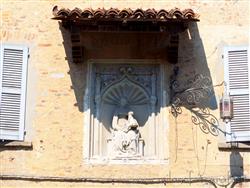|
Fagnano Olona (Varese, Italy): Visconti Castle
|
|
|
Show an other place around Milan worth a visit: |
 The Visconti Castle of Fagnano Olona, long time owned by the Visconti and today the seat of the Municipality, is located in a strategic position on the edge of the town overlooking the Olona Valley. The Visconti Castle of Fagnano Olona, long time owned by the Visconti and today the seat of the Municipality, is located in a strategic position on the edge of the town overlooking the Olona Valley.
HISTORY
It is not known precisely when the castle was built. It seems that already in Roman times a fortified structure was present on the site.
In the thirteenth century, according to some sources as early as 1257, according to others in 1277 after the battle of Desio which saw the victory of the Visconti over the Torriani and the birth of the Visconti dominion over Milan, the castle became the property of the Visconti, in particular that branch of the Visconti family known as Visconti of Fagnano. It should be noted that at the time there was also a second castle in Fagnano, called "Castellazzo" of which, unfortunately, very little remains today. This second castle, on the other hand, came into possession of the Visconti branch called "di Ierago".
In 1451 the castle was entrusted by the Duke of Milan to his adviser Gaspare Visconti, who then passed it on to his son Filippo Maria, Count of Albizzate. To the latter we owe the two towers of the castle, in fact a fortress at the time, and its extension with a series of service rooms.
The castle was besieged several times during the numerous wars that afflicted the Duchy of Milan in the sixteenth century.
When in 1585 the castle became, by dynastic way, property of Gaspare Visconti, bishop of Milan after Carlo Borromeo, it is therefore assumed that it was in a bad state.
Gaspare Borromeo then restored the structure and transformed it from a fortress with a primarily military function into a castle with a primarily residential function. To this end, he added a new block of buildings on the town side, thus creating a second courtyard (the first entering from the main entrance).
After a long decline, the castle was finally purchased by the Municipality of Fagnano Olona which subjected it to numerous restorations. It is currently the seat of the Municipality and a space for cultural events of various kinds.
STRUCTURE
The castle has an asymmetrical structure and is equipped with two courtyards. The main entrance is reached by passing over a bridge that crosses the moat, which still exists but is no longer full of water as it originally was. The main entrance is bordered by a large wrought iron gate framed by a large ashlar stone portal made more imposing by two columns. The door and the walls that connect it to the two lateral bodies are crossed above by an elegant balcony with a stone balustrade.
The first courtyard to be accessed is the one from the Baroque period. It is separated from the second courtyard, from the 15th century, by a passing triportico with ashlar pillars (Fig. 2).
The second courtyard is the part of the castle that best preserves the aspect of a typical quadrangular Visconti fortress. Of the towers, which originally had to be four, one in each corner, only two remain, one of which is lowered. The Visconti coat of arms is still present, both on the back wall, for those who enter, and on the wall of the triporticus, so as to be visible to those who leave. The Visconti coat of arms, with the dragon swallowing a child, is also present in various copies in other parts of the castle, sometimes accompanied by the letters F and M, initials of Filippo Maria Visconti, lord of the castle around the middle of the fifteenth century.
On the walls of the fifteenth-century courtyard (Fig. 4) there are also recognizable traces of frescoes of an eminently decorative nature and the remains of late Gothic window frames today walled up.
Along the upper part of the walls originally ran Ghibelline battlements which were subsequently "capped" by the roof which was added when the fortress structure was transformed into a residential castle.
On the side facing the Olona valley, the castle has on the ground floor a large terrace which offers a panoramic view over the whole valley.
On the façade towards the town it is possible to admire a beautiful stone bas-relief, restored in 2000 by the Proloco and depicting a Nursing Virgin (figure in evidence).
What was originally the castle armory is now the municipal council chamber. The Fireplace Room (Fig. 5) is today the headquarter of the Proloco.
During the recent restorations promoted by the Proloco of the oldest part of the castle, a room which had been forgotten and which originally had probably the function of a warehouse was brought back to light.
Inside the castle there is also a very ancient and very well preserved well. Inside, furthermore, in many places, there are still remains of frescoes, both purely decorative and depicting coats of arms and initials.
Finally, it deserves to be mentioned that the castle is associated with many stories, including recent ones, of ghosts!
Categories: Places of historical value
21054 Fagnano Olona VA |
Further pictures of Visconti Castle in the section Photography |